在岩土工程中的土体过滤器、环境工程中的供水滤池、石油工程中的水驱采油、土壤/地下水污染修复、地下水人工回灌、浑水灌溉和土壤侵蚀等许多工业和工程应用中,均存在悬浮颗粒在多孔介质中的运移现象,并导致介质孔隙堵塞和渗透性能降低问题[1-7]。悬浮颗粒在多孔介质中会发生两种效应:滞留(造成堵塞,导致多孔介质渗透性降低)、随渗流迁移(可能改变多孔介质孔径分布,造成侵蚀作用)[8]。堵塞表示悬浮细小颗粒,如沙粒、淤泥、黏土、细菌和胶体颗粒等,在通过多孔介质时的沉积过程。研究表明,多孔介质内的堵塞分为物理、化学和生物堵塞,而物理堵塞占比例最大。物理堵塞会限制颗粒在土壤和其他多孔介质中的运动[9-10],从而增加了介质的水力梯度,进而导致多孔介质的渗透性降低[3]。其次,胶体等悬浮颗粒比表面积很大,对污染物具有强烈的吸附作用,在随水流迁移的过程中会促进污染物的迁移扩散[11-13]。因此了解胶体等悬浮颗粒在多孔介质中的迁移沉积行为,在许多学科均具有重要的科学意义。
多孔介质的入渗性能受多种因素的影响:介质的导电性能[14]、入渗水的颗粒浓度[3, 7]、介质的粒度分布[15-16]、孔隙大小分布[16],以及晶粒的几何形状和表面粗糙度[17]等。胶体颗粒在多孔介质中迁移沉积现象是复杂且多变的,国内外已经有很多关于胶体颗粒在多孔介质迁移沉积的研究。Reddi等[18]对不同悬浮物在滤砂中迁移的实验表明,粒径效应没有浓度变化效应明显,认为这是由于小颗粒发生絮凝造成的;Xie等[19]通过岩心驱油实验发现,细粒运移是导致渗透性降低的主要原因;Dikinya等[20]采用恒压装置在饱和条件下采用不同电解质溶液对土柱进行浸出,发现相对渗透系数随电解质浓度的降低而显著降低,这是由于在浸出过程中,黏土组分分离后再次沉积造成的;王子佳[21]通过室内回灌实验发现悬浮颗粒粒径与多孔介质孔径的相对比值(dp/D50)是决定堵塞速率的关键因素,当入渗介质的粒径一定时,悬浮物颗粒越大,即dp/D50越大,悬浮物越不易通过介质孔隙,导致堵塞速率加快;戴传山等[22]通过悬浮颗粒砂柱实验发现,悬浮液浓度C0和悬浮颗粒与多孔介质的相对直径比值(dp/Dp)对相对渗透系数的变化有很大影响。可见颗粒浓度与粒径是影响介质渗透性的重要因素,但在以往文献中对介质粒径的研究较少,且大多用相对渗透系数K/K0的变化对介质渗透性进行分析,比较单一。
为了深入探讨胶体颗粒在多孔介质中的运移沉积行为,本文同时考虑了颗粒浓度、颗粒粒径与多孔介质粒径对介质渗透性的影响,用石英砂柱不同部分的相对渗透系数K/K0、浓度及总体流速随时间的变化进行定量描述,对总体相对渗透系数随时间的变化进行回归分析,并将实验结束后的砂柱样品用扫描电镜做定性分析以进一步揭示胶体颗粒的沉积特征。
1 材料与方法 1.1 实验装置胶体颗粒在多孔介质中运移的实验装置如图 1所示,由定水头装置、供水装置、砂柱、测压装置等部分构成[2]。供水装置包括供水桶、小型水泵和电动搅拌器(使颗粒保持悬浮状态);定水头装置包括上部和下部定水头,其中上部定水头在砂柱上端的溢流口处,下部定水头在砂柱底部的方形有机玻璃盒处,上、下部水头差可以控制砂柱中渗流的流速;测压装置是在砂柱侧边开孔通过胶管连接的测压管,用于读取不同位置的水头值。砂柱为长40 cm,内径6 cm的有机玻璃柱,装填石英砂部分为24 cm,底部出口处放置孔径为0.1 mm的滤网,防止多孔介质颗粒随渗流流出砂柱;在距砂柱顶端5 cm处有溢流口,柱体侧边共开7个测压口,第一个测压口设在与上部石英砂持平处,其余测压口分别位于距第一个测压口3、6、10、15、19、24 cm处;柱体的另一侧有4个取样口,分别位于砂柱装填部分的2、5、14和22 cm处,用于取样测定胶体颗粒的浓度。
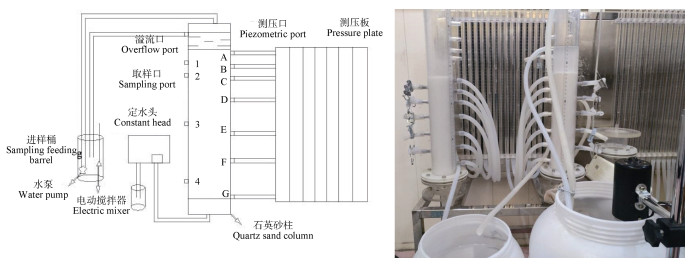
|
图 1 实验装置图 Fig. 1 Schematic diagram of the experimental apparatus |
本实验多孔介质选用3种不同粒径分布的石英砂,粒径范围分别为180~300、300~425和425~600 μm。胶体颗粒选用的硅微粉,是由天然石英(SiO2)或熔融石英经破碎、球磨、浮选、酸洗提纯、高纯水处理等多道工艺加工而成的,纯度99.9%,化学性质稳定,与多孔介质无静电吸附作用。实验选用粒径dp分别为2.6、6.5和13 μm的硅微粉,配制浓度分别为0.1、0.2和0.5 g·L-1。Siriwardene等[23]认为,多孔介质发生物理堵塞导致渗透率降低主要是由于直径小于≤6 μm的胶体颗粒运移造成的,Reddi等[18]认为,在大多数过滤系统中迁移的颗粒絮凝体在10 μm左右,因此本研究选用上述三种粒径的胶体颗粒,涵盖了迁移颗粒的可能范围,以此考察迁移颗粒大小对多孔介质的堵塞作用。实验条件如表 1所示。
|
|
表 1 实验条件 Table 1 Experiment conditions |
本研究用3种不同浓度的胶体溶液在同一饱和多孔介质中的入渗实验,探讨胶体溶液浓度对介质渗透性的影响;用同一浓度、3种不同粒径的胶体溶液在同一饱和多孔介质中的入渗实验,揭示胶体颗粒粒径对介质渗透性的作用机理;用同一浓度和粒径的胶体颗粒在3种不同粒径范围的饱和多孔介质中的入渗实验,分析介质渗透性对介质粒径的响应,共计7种情况。每次实验前将石英砂分别用酸、碱各洗24 h,再用蒸馏水洗至中性,在105 ℃下烘干[24];通过湿法装样将石英砂分层装入砂柱中,底部先铺2 cm粗砂,之后每3 cm装一次样,分8次填装,砂柱容重约为1.55 g·cm-3。先从底部连续注水饱和24 h,排除砂柱中的截留空气,之后换为上部进水,保持上、下部的水头差为10 cm,待测压管水头稳定后计算初始渗透系数K0。之后用水泵将悬浊液以0.5~6 L·h-1的流量从上至下输入砂柱中,并保证有悬浮液从溢流口流出;分别在进样后2、5、8、11、14、18、22、26、30、34、38、42、46、50、54和59 h时观测每个测压管的水头值h和出流量Q,由此计算砂柱不同分段的渗透系数K和砂柱总体渗透系数。同时从砂柱2、5、14和22 cm处取样孔和出水口处取样测定出流液的浓度。
1.4 砂柱渗透性变化的表征方法采用相对渗透系数K/K0来表征胶体颗粒滞留等引起的砂柱渗透性的变化,其中K0和K是根据达西定律进行计算的:
| $ {K_{\rm{0}}}{\rm{ = }}\frac{{{Q_{\rm{0}}} \cdot \Delta x}}{{{\rm{ \mathsf{ π} }}{r^2} \cdot \Delta h}}{\rm{ }}\;\;K{\rm{ = }}\frac{{Q \cdot \Delta x}}{{{\rm{ \mathsf{ π} }}{r^2} \cdot \Delta h}} $ | (1) |
式中,K0为介质初始渗透系数(m·d-1);K为各时刻渗透系数(m·d-1);Q0为初始出流量(m3·d-1);Q为各时刻出流量(m3·d-1);△x为任意两测压管之间的距离(m);△h为两测压管间的水头差(m);r为有机玻璃柱内径(m)。
同时,采用相对流速v/v0(v0为初始渗流流速,v为各时刻渗流流速)分析介质渗透性变化情况,根据不同时间砂柱的出流量计算渗流流速的变化,计算公式为:
| $ v = \frac{Q}{F} = \frac{Q}{{{\rm{ \mathsf{ π} }}{r^2}}} $ | (2) |
式中,v为各时刻渗流流速(m·d-1);F为过水断面面积(m2);Q为各时刻出流量(m3·d-1);r为有机玻璃柱内径(m)。
用浊度仪对不同位置采集的样品进行浊度测定,并将浊度转化为浓度,采用浓度变化对胶体颗粒在多孔介质中的迁移进行分析。为了进一步说明多孔介质渗透性的变化,实验结束后对石英砂柱取样做扫描电镜,分析多孔介质堵塞情况。
2 结果与讨论 2.1 不同因素对渗透性的影响 2.1.1 胶体颗粒浓度对渗透性的影响图 2为粒径为6.5 μm、浓度分别为0.1、0.2和0.5 g·L-1的硅微粉悬浮液在Dp为362 μm的石英砂柱中入渗时整个砂柱相对渗透系数的变化,总体来看,胶体颗粒浓度越高,砂柱的相对渗透系数下降越快。图 3为各渗流段的K/K0-t关系曲线,由图可以看出,不同浓度入渗时的相对渗透系数均呈下降趋势,胶体颗粒浓度越高,各段渗透系数越低,这是由于浓度越高,孔隙内胶体颗粒的滞留率越高;但降低程度有差别,在入渗的初始阶段下降较快,之后下降速度放缓;对于四段土柱的渗透系数曲线而言,AB段即砂柱表层段的相对渗透系数下降最快,其次分别为BC、CE、EG段。

|
注:K0为初始渗透系数,K为各时刻渗透系数。下同。 Note:K0 stands for initial permeability coefficient, and K for permeability coefficient at each moment. The same as below 图 2 不同胶体颗粒浓度下砂柱总体相对渗透系数随时间的变化 Fig. 2 Temporal variation of overall relative permeability coefficient of the sand column relative to concentration of the colloidal particles |

|
注:四条曲线分别表示渗流段AB(0~3 cm)、BC(3~6 cm)、CE(6~15 cm)、EG(15~24 cm)的K/K0随时间的变化。下同。 Note:The four curves represent temporal variation of K/K0 in the seepage section AB(0~3 cm), BC(3~6 cm), CE(6~15 cm)and EG(15~24 cm). The same as below. 图 3 不同胶体颗粒浓度处理下各渗流段相对渗透系数随时间的变化 Fig. 3 Temporal variation of relative permeability ratio of each seepage section relative to concentration of the colloidal particles |
对于AB段,0.1、0.2和0.5 g·L-1的胶体浓度入渗时K/K0降至50%所用的时间分别约为25、13和10 h,如图中黑色垂线所示位置;实验结束时K/K0分别降为原来的17.2%、11.7%和10.2%,这说明胶体颗粒浓度越大,越容易在表层沉积,使得表层K/K0下降得较快。对于BC段,K/K0降至50%所用的时间分别约为59、29和26 h,实验结束时K/K0分别降为原来的56.5%、26.2%和30.6%,这表明胶体颗粒除了在表层沉积,还向土柱下部运移并沉积。对CE和EG段而言,K/K0变化幅度不大,说明沉积在这两段的胶体颗粒已不多。
通常而言,颗粒浓度影响着渗透系数降低的速率,入渗的胶体颗粒浓度越高,渗透系数下降越快,这是由于孔隙流中颗粒的载荷增加所致[14]。但由图 3可以看出,0.1和0.2 g·L-1入渗浓度的AB和BC段的K/K0下降程度差异较大,而0.2和0.5 g·L-1的AB和BC段K/K0差异不大,但CE和EG段差异较大,这说明在超过一定堵塞状态后,无论孔隙流中颗粒的浓度如何,堵塞孔隙中的流速均足以在表层不发生明显沉积的情况下传导颗粒[18]。
2.1.2 胶体颗粒粒径对渗透性的影响本次实验选取了粒径dp分别为13、6.5和2.6 μm、浓度为0.2 g·L-1的硅微粉和Dp为362 μm的石英砂进行实验。由图 4可知,砂柱总体相对渗透系数K/K0差异性不明显,粒径大的胶体颗粒对应的K/K0相对减小得大些,这是因为不同粒径的胶体颗粒在不同位置沉积导致多孔介质每段的渗透系数下降程度不同,但总体上会产生互补效应,使得总体渗透系数的变化程度差异不大。虽然粒径大的胶体颗粒对表层的相对渗透系数的影响较大,但从总体渗透系数随时间变化曲线来看,其粒径效应并不如浓度效应变化明显,这也可能是由于粒径小的颗粒更易发生絮凝或凝聚,产生大的团聚体,使得其效应更接近大颗粒[18]。
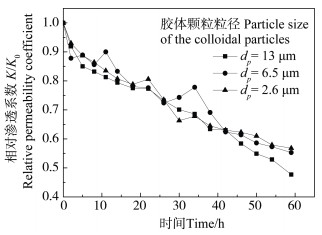
|
图 4 不同胶体颗粒粒径处理下砂柱总体相对渗透系数随时间的变化 Fig. 4 Temporal variation of overall relative permeability coefficient of the sand column relative to particle size of the colloidal particles |
由图 5a)可知,AB、BC、CE和EG段在实验结束时,K/K0分别降为原来的11.7%、26.2%、81%、95.2%,AB段下降速率最快,在10 h左右即降为初始渗透系数的50%,这表明粒径大的胶体颗粒易在表面滞留沉积,堵塞孔隙,减小入渗率。图 5b)中各段在实验结束时K/K0分别降为原来的19.1%、33.8%、80.4%和94.6%,可以看出CE、EG段下降较快,但AB、BC段的下降速率明显较图 5a)慢。图 5c)中各段在实验结束时K/K0分别降为原来的19.5%、35.9%、61.3%和80.1%,AB和BC段K/K0下降速率明显低于图 5a)和图 5b),但CE和EG段的下降速率高于图 5a)和图 5b)。这是因为对于相对较大的颗粒,滞留在其沉积过程中发挥着重要的作用,滞留表示颗粒无法通过小孔喉而被截留的现象。而粒径较小的胶体颗粒易随水流到达更深处滞留,表层沉积量较少,导致渗透率下降比较明显[9]。

|
图 5 不同胶体颗粒粒径处理下各渗流段相对渗透系数随时间的变化 Fig. 5 Temporal variation of relative permeability ratio in each seepage section relative to particle size of the colloidal particles |
实验选择了3种粒径的石英砂,Dp分别为240、362和513 μm,胶体颗粒粒径为6.5 μm,浓度为0.2 g·L-1。由图 6总体相对渗透系数随时间变化可知,胶体颗粒在粒径大的多孔介质中更易向下部迁移沉积,导致总体K/K0变化较大;而对于粒径小的多孔介质,胶体颗粒易滞留在表层,总体K/K0变化不大。有研究指出中细砂更容易发生表面堵塞,而粗砂容易发生内部-表面双重堵塞,从而导致堵塞速率和部位不相同[21]。多孔介质粒径越大,孔隙越大,其捕获悬浮颗粒的能力越低,悬浮颗粒易在其中迁移;而粒径小的介质,孔隙较小,颗粒难以通过,易在表面沉积[3],上述现象从图 6中也可以体现出来。

|
图 6 不同多孔介质粒径处理下砂柱总体相对渗透系数随时间的变化 Fig. 6 Temporal variation of overall relative permeability coefficient of the sand column relative to particle size of the porous media |
通过图 7可以看出,图 7a)中土柱各段K/K0均有明显下降,至实验结束时AB、BC、CE和EG的K/K0分别降为原来的16.5%、28.5%、43.9%和68.5%。图 7b)中AB和BC段有比较明显的降低,K/K0降为原来的11.7%、26.2%,而CE和EG段分别降为起始的81%和95.2%,变化不大,这是由于介质孔径小导致大部分颗粒在表层沉积[25]。图 7c)中AB段和BC段K/K0轻微降低,K/K0降为原来的93.1%和99.4%,CE和EG段K/K0均有明显增大的现象,在后面部分会讨论相对渗透系数增大的原因。

|
图 7 不同多孔介质粒径处理下各渗流段相对渗透系数随时间的变化 Fig. 7 Temporal variation of relative permeability ratio in each seepage section relative to particle size of the porous media |
为了定量地了解整个砂柱渗透性能随时间的变化特征,将上述不同条件下土柱总体相对渗透系数(用y表示)与时间(用x表示)进行回归分析,结果见表 2。由表中回归方程和R2可知,除处理1外,其余实验砂柱总体相对渗透系数y与时间x之间呈二次方相关关系,R2 > 0.92,均具有较好的相关性。处理1选用的石英砂相比于处理4和7而言的石英砂较细,总体相对渗透系数与时间之间没有明显的相关性,表明介质粒径过小时,渗透性能随时间降低的规律不显著,而处理4和7相比处理4的R2较高,这说明在胶体颗粒浓度与粒径相同时,Dp为362 μm的石英砂柱的总体相对渗透系数与时间的相关性较好;3、4、5处理相比,处理5的R2最高,表明在石英砂粒径和胶体颗粒粒径相同时,浓度大的胶体溶液处理下砂柱的总体相对渗透系数与时间的相关性较好;处理2、4、6相比,处理4的R2最高,说明在石英砂粒径和胶体溶液浓度相同时,dp为6.5 μm的胶体颗粒处理下的总体相对渗透系数与时间的相关性较好。
|
|
表 2 砂柱总体相对渗透系数与时间的回归分析 Table 2 Regression analysis of overall relative permeability coefficient of the sand column with time |
胶体颗粒的滞留和沉积对砂柱渗透性能有很大影响,渗流流速随时间变化很大[7]。渗流流速变化与介质渗透性变化关系密切,由达西定律可知,水通过多孔介质的速度同水力梯度的大小及介质的渗透性能成正比[26]。不同因素影响下的流速变化如图 8所示,总体而言胶体颗粒浓度、粒径和多孔介质粒径越大,流速降低地越快。流速降低最慢和最快的分别为处理3和5,即浓度为0.1 g·L-1和0.5 g·L-1的胶体颗粒,v分别降为原来的56.52%和12%。由3、4、5处理可知,流速降低速度由大到小分别为5、4、3处理,这表明其余条件相同时,浓度越大,越易发生堵塞,流速降低越快;由2、4、6处理可知,处理2即dp为2.6 μm的胶体颗粒入渗时流速降低最慢,其次分别为dp为13和6.5 μm的胶体颗粒,表明胶体颗粒粒径对流速变化不明显,这与上文多孔介质渗透性变化相一致;由处理1、4、7可知,流速降低速度由大到小分别为7、4、1处理,这表明在相同胶体颗粒入渗的情况下,介质粒径越大,胶体颗粒易向下部迁移,在介质表层和下部发生双重堵塞,从而使得流速降低越快。
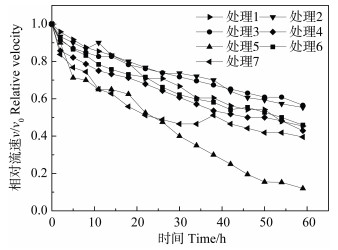
|
注:图中处理1、2、3等与表 1中的实验处理对应;v0为初始渗流流速,v为各时刻渗流流速。 Note:Treatments 1, 2 and 3, etc. in the figure correspond to the experiment treatments in Table 1; v0 stands for initial seepage velocity, and v for seepage velocity at each moment. 图 8 不同条件下相对流速随时间的变化 Fig. 8 Temporal variation of flow rate relative to treatment |
本实验对一系列已知浓度的胶体悬浮液浊度进行测定得出浊度和浓度的关系,发现粒径为6.5和13 μm的胶体颗粒浓度和浊度的关系分别为y=0.0012x-0.0003和y=0.0013x+0.0002,R2为0.9973和0.9975,说明两者具有高度相关性,可以用浊度来反映浓度的变化。对实验4和6不同位置的浓度变化进行分析,由于表层与底部浓度的数量级差距较大,所以以log10C-t作图分析,两种粒径的胶体颗粒浓度变化见图 9。
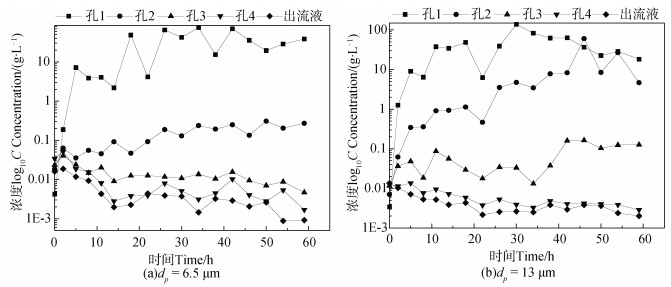
|
图 9 砂柱不同位置胶体颗粒浓度随时间的变化 Fig. 9 Temporal variation of concentration of colloidal particles relative to position in the sand column |
由图 9可以看出,砂柱不同位置处胶体颗粒浓度随时间变化差别较大,随着时间的延长,整体上呈现先增加后降低或趋于稳定的趋势,在前期浓度变化幅度较大,后期仅上下浮动。由图 9可知,当胶体颗粒粒径为6.5 μm时,土柱5个不同位置处(从上到下)胶体颗粒浓度的最大值分别为76.9、0.309、0.040、0.052和0.019 g·L-1;当胶体颗粒的粒径为13 μm时,土柱5个不同位置处胶体颗粒浓度的最大值分别为138.6、60.6、0.164、0.014和0.010 g·L-1,大颗粒在14 cm以上沉积较多,而小颗粒能更多地迁移至14 cm以下,表明小颗粒较大颗粒更易向下部迁移。由于本实验选用的胶体颗粒和多孔介质的成分均为SiO2,化学性质稳定,不考虑静电吸附作用,可以认为是多孔介质的筛滤作用造成的,胶体颗粒粒径越大筛滤作用越明显[27-28]。不同位置的浓度越大,K/K0降低越快,这与相对渗透系数的变化相对应。
2.3 胶体颗粒沉积电镜分析对处理5结束后的多孔介质进行分析,表面沉积层的形成得到了直观的确认,如图 10所示。为了进一步证实以上实验结果,用扫描电镜(SEM)对实验结束后的多孔介质颗粒进行了微观分析,显微图(图 11)显示石英砂颗粒表面光滑且有明显的沉积物,说明胶体颗粒会在多孔介质表面沉积,堵塞孔隙。
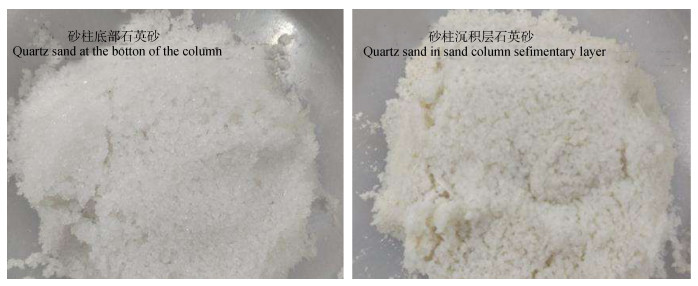
|
图 10 多孔介质下部与表层对比图 Fig. 10 Constrast of the parts of the porous media in the bottom and surface |
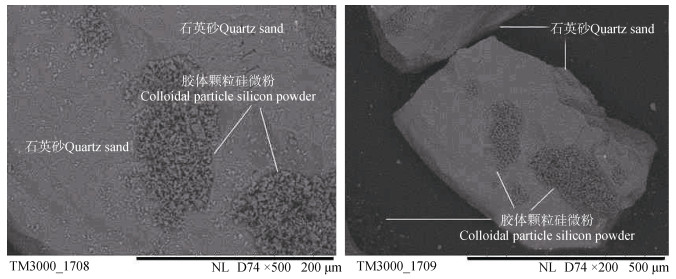
|
图 11 实验后多孔介质扫描电镜图像 Fig. 11 Scanning electron microscopic images of the porous media porous media after the experiment |
通常而言,胶体颗粒入渗会造成介质孔隙堵塞,从而使渗透性下降,渗透系数减小。但从图 3、图 5(a)和图 7(c)中可以发现,随着实验观测时间的增长,CE和EG段K/K0有增大甚至大于1的现象。对此也有文献得出了胶体颗粒在多孔介质中入渗并不一定会导致相对渗透系数下降的结论,但解释却不尽相同[21-22, 29-30]。田燚等[30]认为由于多孔介质粒径过小而悬浮物浓度高,使得砂柱表层堵塞严重,表层渗透系数下降迅速难以继续渗透,砂柱内部可能处于非饱和状态。路莹[29]认为是多孔介质中的空气溶于水所导致的,且深度越深,其中的空气就越难排出,从而出现底部渗透系数增大的现象;而戴传山等[22]则认为实验过程中应尽量保证砂柱中无气泡存在,认为这与悬浮颗粒和多孔介质粒径的相对直径比dp/Dp有关,当在dp/Dp比值> 0.02且悬浮颗粒浓度小于1.0 g·L-1的情况下会出现局部相对渗透系数增大的现象。由于胶体的流动浓度由其沉积的相对大小和释放速率决定,胶体溶液在体系中的停留时间也起着重要的作用,停留时间越长,越接近颗粒沉积与释放的平衡状态,而停留时间越短,则越有利于胶体沉积而非释放[31]。因此本文认为渗透系数增大可能是由于进样时间较长,表层颗粒沉积不易向下迁移,下部已沉积的颗粒释放流出砂柱,导致渗透系数增大。
本实验计算了相对直径比dp/Dp与实验结果相结合,参照戴传山等[22]的数据解释,绘制了不同文献数据的对比图,发现当dp/Dp > 0.018且浓度小于0.5 g·L-1时,会出现K/K0增加的现象,而dp/Dp < 0.018时,未出现K/K0增加的现象。实验结果与戴传山等[22]的解释有偏差,可能是由于所用装置与实验条件有差异,其次浓度大于0.5 g·L-1的入渗实验还未进行,且胶体颗粒在多孔介质中迁移沉积的机理复杂,今后会继续进行实验探讨有关相对渗透系数增大的原因,文献数据对比图见图 12。

|
注:dp为胶体颗粒粒径,Dp为石英砂算数平均粒径。 Note:dp stands for colloidal particle size, and Dp for arithmetic average particle size of quartz sand. 图 12 不同文献数据对比图 Fig. 12 Comparison of the different data in the literature |
本研究采用了3种胶体粒径、3种浓度的胶体溶液和3种粒径范围的石英砂,开展了定水头条件下不同浓度和粒径的胶体颗粒在不同粒径范围的饱和多孔介质中的运移行为研究。得出以下结论:(1)胶体颗粒在多孔介质中运移会造成物理堵塞,导致渗透性降低。(2)胶体颗粒在多孔介质中的迁移沉积受胶体颗粒浓度、胶体颗粒粒径和多孔介质粒径的影响,胶体颗粒浓度、胶体颗粒粒径和多孔介质粒径越大时,渗透性降低得越快。(3)介质渗流流速及砂柱不同位置胶体颗粒浓度变化也反映出胶体颗粒对介质的堵塞。(4)当输入浓度C0小于0.5 g·L-1且dp/Dp > 0.018时,会出现多孔介质局部K/K0增大的现象。
| [1] |
Moghadasi J, Müller-Steinhagen H, Jamialahmadi M, et al. Theoretical and experimental study of particle movement and deposition in porous media during water injection . Journal of Petroleum Science and Engineering, 2004, 43(3/4): 163-181.
(  0) 0) |
| [2] |
郑西来, 单蓓蓓, 崔恒, 等. 含水层人工回灌物理堵塞的实验与数值模拟. 中国地质大学学报(地球科学), 2013, 38(6): 1321-1326. Zheng X L, Shan B B, Cui H, et al. Test and numerical simulation on physical clogging during aquifer artificial recharge (In Chinese). Journal of China University of Geosciences(Earth Science), 2013, 38(6): 1321-1326. (  0) 0) |
| [3] |
Yousif O, Karakouzian M, Rahim N, et al. Physical clogging of uniformly graded porous media under constant flow rates . Transport in Porous Media, 2017, 120(3): 643-659.
(  0) 0) |
| [4] |
Zeinijahromi A, Vaz A, Bedrikovetsky P. Well impairment by fines migration in gas fields . Journal of Petroleum Science and Engineering, 2012, 88/89(2): 125-135.
(  0) 0) |
| [5] |
刘庆玲, 徐绍辉, 刘建立. 饱和多孔介质中高岭石胶体和SiO2胶体运移行为比较. 土壤学报, 2008, 45(3): 445-451. Liu Q L, Xu S H, Liu J L. Comparison between kaolinite and SiO2 colloid in transport behavior in saturated porous media (In Chinese). Acta Pedologica Sinica, 2008, 45(3): 445-451. (  0) 0) |
| [6] |
刘庆玲, 徐绍辉, 刘建立. 离子强度和pH对高岭石胶体运移影响的实验研究. 土壤学报, 2007, 44(3): 425-429. Liu Q L, Xu S H, Liu J L. Effects of ionic-strength and pH on kaolinite transport in saturated porous media (In Chinese). Acta Pedologica Sinica, 2007, 44(3): 425-429. (  0) 0) |
| [7] |
姚雷. 浑水入渗滞留实验研究. 北京: 清华大学, 2004. Yao L. Experimental study on remainer during muddy water infiltrating (In Chinese). Beijing: Tsinghua University, 2004. (  0) 0) |
| [8] |
Khilar K C. Migrations of fines in porous media . Springer-Science+Business Media, B.Y: Kluwer Academic, 1998.
(  0) 0) |
| [9] |
Alem A, Elkawafi A, Ahfir N D, et al. Filtration of kaolinite particles in a saturated porous medium:Hydrodynamic effects . Hydrogeology Journal, 2013, 21(3): 573-586.
(  0) 0) |
| [10] |
Pavelic P, Dillon P J, Mucha M, et al. Laboratory assessment of factors affecting soil clogging of soil aquifer treatment systems . Water Research, 2011, 45(10): 3153-3163.
(  0) 0) |
| [11] |
Sun H M, Gao B, Tian Y, et al. Kaolinite and lead in saturated porous media:Facilitated and impeded transport . Journal of Environmental Engineering, 2010, 136(11): 1305-1308.
(  0) 0) |
| [12] |
翟振乾. 悬浮颗粒对重金属离子渗流迁移过程影响的实验研究. 北京: 北京交通大学, 2017. Zhai Z Q. Laboratory test on the effect of the suspended particle on the seepage migration of heavy metal irons (In Chinese). Beijing: Beijing Jiaotong University, 2017. (  0) 0) |
| [13] |
邵珍珍, 林青, 徐绍辉. 不同离子强度下SiO2胶体对磺胺嘧啶土壤吸附迁移行为的影响. 土壤学报, 2018, 55(2): 411-421. Shao Z Z, Lin Q, Xu S H. Effect of silica colloids on adsorption and migration of sulfadiazine in soil relative to ionic intensity (In Chinese). Acta Pedologica Sinica, 2018, 55(2): 411-421. (  0) 0) |
| [14] |
Reddi L N, Xiao M, Hajra M G, et al. Physical clogging of soil filters under constant flow rate versus constant head . Canadian Geotechnical Journal, 2005, 42(3): 804-811.
(  0) 0) |
| [15] |
Ahfir N D, Hammadi A, Alem A, et al. Porous media grain size distribution and hydrodynamic forces effects on transport and deposition of suspended particles . Journal of Environmental Sciences, 2017, 53(3): 161-172.
(  0) 0) |
| [16] |
Bennacer L, Ahfir N D, Bouanani A, et al. Suspended particles transport and deposition in saturated granular porous medium:Particle size effects . Transport in Porous Media, 2013, 100(3): 377-392.
(  0) 0) |
| [17] |
Tong M P, Johnson W P. Excess colloid retention in porous media as a function of colloid size, fluid velocity, and grain angularity . Environmental Science & Technology, 2006, 40(24): 7725-7731.
(  0) 0) |
| [18] |
Reddi L N, Ming X, Hajra M G, et al. Permeability reduction of soil filters due to physical clogging . Journal of Geotechnical and Geoenvironmental Engineering, 2000, 126(3): 236-246.
(  0) 0) |
| [19] |
Xie Q, Saeedi A, Delle Piane C, et al. Fines migration during CO2 injection:Experimental results interpreted using surface forces . International Journal of Greenhouse Gas Control, 2017, 65: 32-39.
(  0) 0) |
| [20] |
Dikinya O, Hinz C, Aylmore G. Dispersion and re-deposition of fine particles and their effects on saturated hydraulic conductivity . Australian Journal of Soil Research, 2006, 44(1): 47-56.
(  0) 0) |
| [21] |
王子佳. 城市雨洪水地下回灌过程中悬浮物堵塞规律的实验研究. 长春: 吉林大学, 2012. Wang Z J. Laboratory research on the law of suspended solids clogging during urban stormwater groundwater recharge (In Chinese). Changchun: Jilin University, 2012. (  0) 0) |
| [22] |
戴传山, 祁芸芝, 雷海燕, 等. 悬浮微小颗粒对多孔介质渗流特性影响的实验研究. 水文地质工程地质, 2016, 43(6): 1-6. Dai C S, Qi Y Z, Lei H Y, et al. Deposition effect of suspended microparticle on the local permeability in porous media (In Chinese). Hydrogeology & Engineering Geology, 2016, 43(6): 1-6. (  0) 0) |
| [23] |
Siriwardene N R, Deletic A, Fletcher T D. Clogging of stormwater gravel infiltration systems and filters:Insights from a laboratory study . Water Research, 2007, 41(7): 1433-1440.
(  0) 0) |
| [24] |
Cai L, Tong M P, Wang X T, et al. Influence of clay particles on the transport and retention of titanium dioxide nanoparticles in quartz sand . Environmental Science & Technology, 2014, 48(13): 7323-7332.
(  0) 0) |
| [25] |
肖振华, 万洪富. 灌溉水质对土壤水力性质和物理性质的影响. 土壤学报, 1998, 35(3): 359-366. Xiao Z H, Wan H F. Effect of irrigation water quality on soil hydraulic and physical properties (In Chinese). Acta Pedologica Sinica, 1998, 35(3): 359-366. (  0) 0) |
| [26] |
Swartzendruber D. Darcy's law//Encyclopedia of soils in the environment. Oxford: Elsevier, 2005: 363-369.
(  0) 0) |
| [27] |
陈星欣. 饱和多孔介质中颗粒迁移和沉积特性研究. 北京: 北京交通大学, 2013. Chen X X. Study on the particle transport and deposition in saturated porous media (In Chinese). Beijing: Beijing Jiaotong University, 2013. (  0) 0) |
| [28] |
陈星欣, 白冰, 于涛, 等. 粒径和渗流速度对多孔介质中悬浮颗粒迁移和沉积特性的耦合影响. 岩石力学与工程学报, 2013, 32(S1): 2840-2845. Chen X X, Bai B, Yu T, et al. Coupled effects of particle size and flow rate on characteristics of particle transportation and deposition in porous media (In Chinese). Chinese Journal of Rock Mechanics and Engineering, 2013, 32(S1): 2840-2845. (  0) 0) |
| [29] |
路莹, 杜新强, 迟宝明, 等. 地下水人工回灌过程中多孔介质悬浮物堵塞实验. 吉林大学学报(地球科学版), 2011, 41(2): 448-454. Lu Y, Du X Q, Chi B M, et al. The porous media clogging due to suspended solid during the artificial recharge of groundwater (In Chinese). Journal of Jilin University(Earth Science Edition), 2011, 41(2): 448-454. (  0) 0) |
| [30] |
田燚. 北京市平原典型岩性地下水回灌堵塞及防治的沙柱实验. 北京: 中国地质大学, 2012. Tian Y. The construction of management and assessment system in groundwater over-exploited regions (In Chinese). Beijing: China University of Geosciences, 2012. (  0) 0) |
| [31] |
Bin G, Cao X, Dong Y, et al. Colloid deposition and release in soils and their association with heavy metals . Critical Reviews in Environmental Science and Technology, 2011, 41(4): 336-372.
(  0) 0) |
 2020, Vol. 57
2020, Vol. 57


